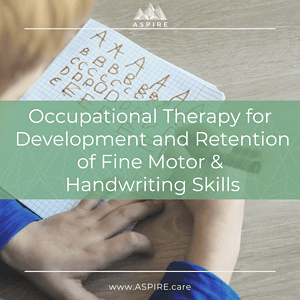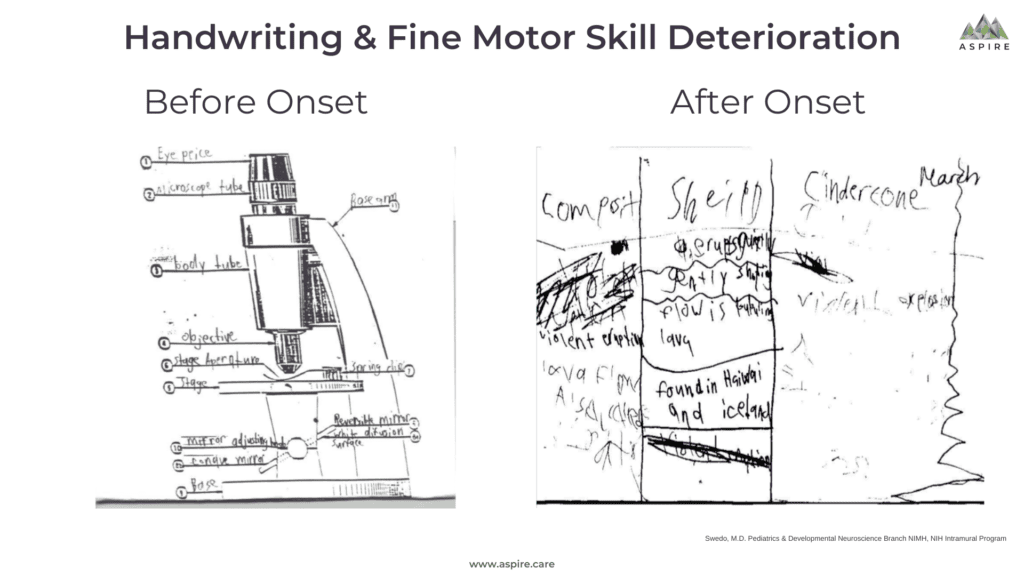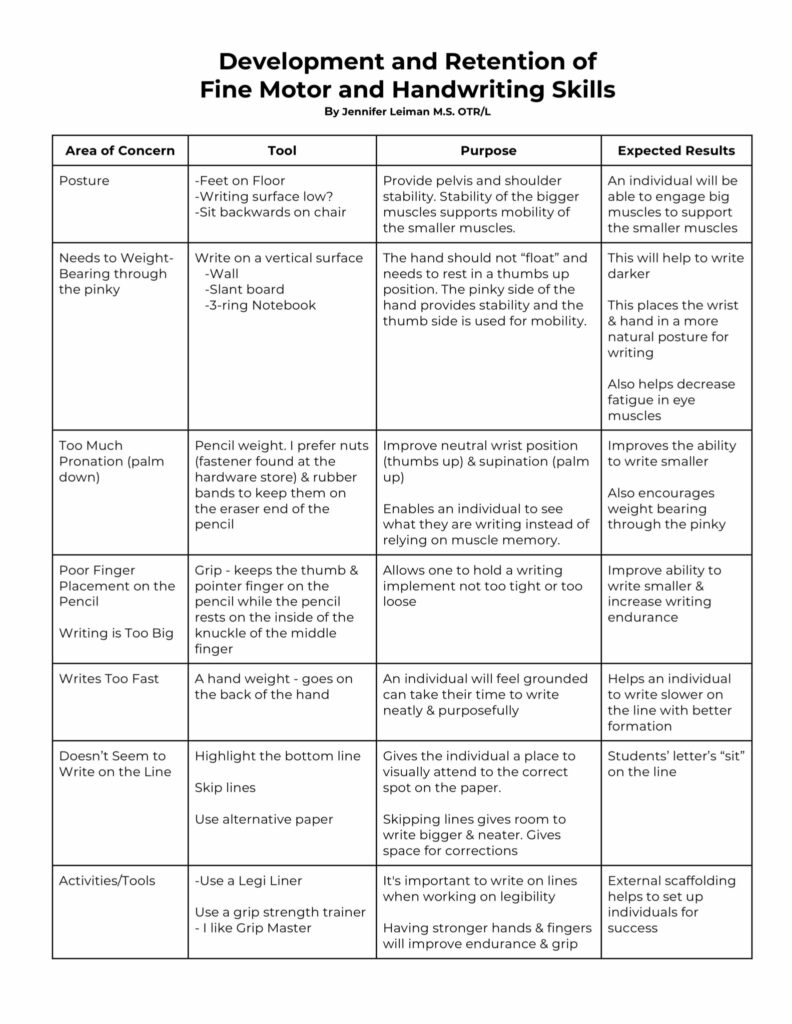Development and Retention of Fine Motor and Handwriting Skills
By Jennifer Leiman M.S. OTR/L

PANS PANDAS can affect many aspects of daily functioning. One of the categories of the PANS diagnostic criteria is Decline in Academic Skills. This category of symptoms includes a wide range of functional skills, including a decline in handwriting abilities and fine motor skills. A change in handwriting may consist of, but is not limited to, not being able to write on the lines, poor formation of letters and numbers, reverse letters and numbers (after 2nd grade), poor spacing between numbers, letters, and words, or writing is too large. A decline in academic skills or handwriting abilities can be a symptom of PANS PANDAS but they are not required for a diagnosis as OCD or restrictive eating in addition to only two out of seven categories is required. (See Symptoms and Diagnosing.)
Developmentally, a child begins to learn pre-writing strokes–drawing lines and copying simple shapes–in preschool. Once in kindergarten, a child is ready to learn how to write capital letters, followed by lower-case letters. However, in recent years there has been a push for students to begin these skills earlier. Unfortunately, learning earlier can result in poor habits as it relates to pencil grasp and formation of letters–no matter a child’s abilities and neurodiversities.
Traditionally, a school-based occupational therapist (OT) in elementary school will focus on improving hand strength (fine motor skills) and drawing and writing skills (visual motor and perceptual skills), as well as regulating sensory processing skills, which can impact a student’s ability to access their education. When a school or family recognizes a child is struggling with these skills beyond the scope of their peers, an OT is brought onto the team. Prior to a complete OT evaluation, a therapist may observe the student and suggest in-the-moment tools to support the mechanics of writing. These can include but are not limited to pencil grips, slant boards, pencil weights and alternative paper. (See more about PANS PANDAS and Occupational Therapy.)
When a child develops PANS/PANDAS prior to their writing skills development, a solid foundation of writing mechanics becomes a vital component for future development of good handwriting skills. If PANS PANDAS starts before or around the time of handwriting development, one may not observe a decline in handwriting abilities. Thus, later one might assume that the student simply has poor handwriting skills, but it is critical to provide them with remedial support to develop these skills. So, even if a student is not in a flare but has poor handwriting skills, it is essential to remember this deficit might be attributed to PANS PANDAS.
If a student develops PANS/PANDAS after they have learned to write, there may be a need to recoup some of these skills throughout or after the flare has resolved. Due to PANS PANDAS’ disease course, therapeutic intervention may not be effective during a flare, so increased adaptations and supports during the flare followed by remedial interventions to resolve persistent handwriting and fine motor issues may be more appropriate. This can be accomplished through adaptive and supportive tools through the student’s teacher or case manager (if they have one). Please refer to the chart below for additional suggestions.
Deterioration of Fine Motor and Handwriting Skills in PANS PANDAS
This graphic exhibits a classic example of the deterioration of fine motor skills and handwriting changes in PANS PANDAS. Before the onset of PANS PANDAS, this student’s handwriting was precise and clear. After the onset of PANS PANDAS, there is a marked deterioration in the same student’s handwriting skills. It is barely legible, no longer neat and precise. Plus, the student is hardly able to apply enough pressure to make marks on the paper.

Occupational Therapy for PANS PANDAS
For more information about how Occupational Therapy can benefit those with PANS PANDAS see the linked page below.
Occupational Therapy For PANS PANDAS
About Jennifer Leiman M.S. OTR/L
 Who I Am My name is Jennifer Leiman. I have been a treating occupational therapist (OT) for about 20 years, and have spent my entire time in pediatrics. I have a wide range of skills with a current focus on implementing strategies for improved legibility, executive function and sensory tools within the structure of a school based setting. I’m also a certified executive function coach. My husband and I live in northern NJ with our two young children. My older son is in middle school and has a diagnosis of Twice Exceptional and my younger daughter is in elementary school with a diagnosis of PANS/Lyme.
Who I Am My name is Jennifer Leiman. I have been a treating occupational therapist (OT) for about 20 years, and have spent my entire time in pediatrics. I have a wide range of skills with a current focus on implementing strategies for improved legibility, executive function and sensory tools within the structure of a school based setting. I’m also a certified executive function coach. My husband and I live in northern NJ with our two young children. My older son is in middle school and has a diagnosis of Twice Exceptional and my younger daughter is in elementary school with a diagnosis of PANS/Lyme.
My Goal I seek to integrate concrete tools that are child-specific yet appropriate for the entire classroom dynamic. I have also developed easy and effective handwriting and organizational strategies, striving to assist students and the classroom staff in achieving a student’s OT goals.
My Therapy Approach I believe in a student-focused, holistic approach, treating your children as if they were my own. I accomplish this by working collaboratively with students, teachers and parents to help each student achieve their greatest potential.



